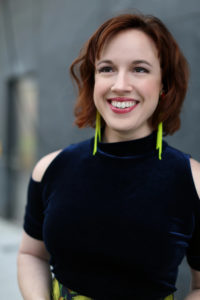
Q&A: Soprano Rainelle Krause on Taking the Queen of the Night to New Heights
By Chris RuelAerialist
noun
: one who performs feats in the air or above the ground, especially on the trapeze.
Does singing “Der Hölle Rache,” the famous Queen of the Night aria, upside down while suspended by yards of silk count as a “feat?” If not, it should because that’s exactly what soprano Rainelle Krause does.
Whether in the air or on the ground, Krause is an artist who has gained traction as one of the industry’s Queens of the Night. She has sung the role with the Danish Royal Opera, Berlin Staatsoper Unter den Linden, and Deutsche Oper Berlin. The Berlin Staatsoper appearance was a jump-in with three-hours’ notice. And that was her role debut!
Singing and aerial work (and doing both simultaneously) require stamina, strength, derring-do, and talent by the ton. The combination of the two arts is quite remarkable to watch. “Der Hölle Rache” on aerial silks is spectacle, pure and simple, and Krause knows that.
“The whole thing [Queen of the Night] is about fireworks in a lot of ways. So, let’s take the gimmick and follow it to its logical conclusion and see what we can build out and make artistic,” Krause related during her conversation with OperaWire.
In her interview with OperaWire, Krause talks about the art of singing high above the stage without a net, her approach to the iconic role, and her future aspirations as she continues to diversify her repertoire.
OperaWire: Which came first, the aerial arts or singing?
Rainelle Krause: Singing definitely came first! I was not an athletic child or young adult. Exposure to aerial work was the first thing that really lit a fire in me to pursue physical fitness. I took my first class while I was attending OperaWorks in LA in 2013, after Kate Conklin, who teaches using the Alexander Technique, encouraged a few of us to check it out.
OW: You have much more to think about than singing when doing both.
RK: Yes, but it’s like the multi-tiered attention required of any performance, just with different particulars: Remember to breathe before you invert HERE, don’t be surprised by the lights HERE, figure out where the audience is in space. These are the different things that run through my head.
OW: What’s the process for choreographing a performance?
RK: I worked with my aerial instructor to construct interesting, artistic choreography that maintains the primacy of the voice — so maybe I can’t do a full backbend with neck extension while I’m singing, but I can get my toes behind my head to approximate that shape while keeping the vocal instrument aligned.
I’m less interested in cranking out a series of tricks than I am in building an artistic experience through movement that will more thoroughly inform the story I want to tell.
OW: How did you get your start singing Queen?
RK: As a young coloratura in a tough field, Queen of the Night is a good foot in the door. If you can sing it, and if you can sing it well, it can be a great springboard. So, it was always in the back of my mind. And after I worked with the Alexander Technique, we actually unlocked a lot of my high extension in a way that I thought finally felt reliable.
It comes back to what can you do under pressure? What can you do in a variety of situations? And when it felt secure, I thought, okay, well this is something that I should do. If the instrument is ready, and if I feel good about it, then absolutely, this is an avenue to pursue. Around five or six years ago, it started feeling really solid, and it had always been in the back of my mind to work with silks too.
My role debut was last December (2019), and that was a jump-in at the Berlin Staatsoper on three hours’ notice. They emailed me and said, “Would you mind coming to sing Queen of the Night tonight for us?” I had been in the country for less than 24 hours. But I was like, yes, I will be right there. Let’s do this. I had been prepping to sing it at Deutsche Oper, so I was fully prepared and ready to sing.
OW: How do you prepare for the role?
RK: I enjoy looking at the different productions and trying to figure out what I want to say about any particular Queen.
The run we were doing in Basel — and hopefully, we’ll be doing again soon — is a very gritty production. The aesthetic is very dark, and the Queen is physically disabled through almost the entire show. That opened my eyes to different nuances, such as frustration and deep anger at herself because of her inability to do what she needs to do on her own.
When she’s putting that on Pamina — I need you to go kill Sarastro — yes, it’s forceful. And yes, it plays on the mother-daughter dynamic, of course. But she needs Pamina to go do the deed because she can’t do it herself. I found that really fun to play with, and it has opened up a lot of different colors for me.
OperaWire: So at what point did the aerial arts enter the picture?
RK: The Queen of the Night is such a magical character that I didn’t think it was inappropriate to put her in the air. It can totally feed into her whole modus operandi. Silks can extend her power and we can play with it visually.
I think it’s really interesting using aerial silks and the motion and emotion of my body to tie it into the character. That’s what elevates it for me and what keeps it fresh.
OW: There’s a part in your aerial routine where it appears as if you’re seated on a crescent moon. That’s brilliant, and it ties into what you’ve just said.
RK: That seated position is about as much rest as you’re going to get in the air. So, it’s useful as well.
It’s a good transition, and at the same time, it is all about what it looks like and what you’re saying. So, absolutely, I’m looking for the connotations in movement and in position to feed into the story I’m selling.
OW: Who have been some of your Queen inspirations?
RK: So many! Edda Moser, obviously, because she’s incredible; the size of the voice, the clarity, the beauty, and the intensity of it all. I mean, she has been a major role model for me in terms of sound.
I’ve listened to Lucia Popp, and I found a lot to love in her recordings, especially her triplets, they are so clean and clear.
And Kathryn Lewek is a force of nature.
There are so many ways of singing this role, and so many different voices that it’s been interesting to take little bits and pieces from different artists and see what feels the best in my own instrument and what sort of rings true with my personality and my experiences. How can I give a more authentic portrayal instead of a pastiche of what I admire about other Queens?
OW: Let’s talk about the other Queen aria, “O zittre nicht.”
RK: I love “O zittre nicht” because it shows so much. It’s really the only chance in the entire show that the Queen gets to sing beautifully. That’s not to say that there isn’t beauty in the other parts, but I mean, you look at that chunk in the middle. What I really like about it is that it shows early on how duplicitous and manipulative the Queen is. I love that.
Do I think that some of her sadness is real? It has to be, but it’s very layered and very complicated. I’m sure it horrifies her that her daughter has been ripped away from her, but I think she also uses her daughter as a possession. So, it becomes a “How dare you take this from me” and less concerned over the well-being of her daughter. That’s a fun dynamic to play with, especially if she’s laying on the emotion really thick. A lot of what she’s doing is checking to see if Tamino is falling for it, like, am I roping him in?
OW: I watched the video in which you sing “Quando me’n vo’” using aerial silks. Are there other arias you’d like to sing in the air?
RK: Oh, yeah. Right now, I’m working on an abridged version of Ophelia’s mad scene. I don’t know if it would ever make sense in the opera’s context, as that would depend. But I think as a standalone piece, there’s a lot there, especially with the water motifs and her own frenetic insanity and break with reality. There’s a lot that could be shown very effectively by playing with height or rolling around on the ground. With silks, if you’re holding very low and then running and swinging, there’s a lot of momentum involved. You can make really ugly, disturbing shapes by tying yourself up in certain ways, and obviously, you can make a lot of very beautiful shapes too.
That’s the thing I love about silks. It’s the way they move. It’s very different from any other apparatus. And even just the presence of silks on the stage. If you just spread that fabric out, you can say a lot without doing very much, which then makes it more impressive if you’ve built up the act in such a way that people are ready when you do a major drop, or when you lay yourself out in a particular split.

Credit: Michael Schulze
OW: Audiences love Queen. But for singers, there’s a fear that comes along with it.
RK: Yes, absolutely. Every person I’ve talked to, colleagues, conductors, and directors, the first thing they ask is, “Oh, what else do you sing?” which is interesting and smart. I’m glad that I have people who are pushing me to think ahead. What do you want to sing in three years? What do you want to sing in five years? It’s easy to make a living off of Queen and nothing else. And there is no shame in that. But musically, if there are other things that you want to accomplish, I think it’s really important to use it as a foot in the door.
I will sing Queen as long as I physically am able, as long as it feels good, because I’m still so interested in it. I haven’t been singing it for years in productions. There’s a lot left that I want to play with, but I want to make sure that I’m building a path. If the day comes that I felt artistically tapped out with it, I want to make sure there are other things that people know me for. And luckily, the people on my team have been really encouraging with that style of thinking.
OW: Related to the point you just made, what are some roles you’d like to sing?
RK: In the short term, I would love to sing a Gilda. Absolutely love it.
Maybe a couple of years down the line, I’ll start looking at Violetta, depending on how my voice matures and depending on the sound that people want. Violetta is one of those roles that people have very specific tastes. But those tastes are wide and varying. Will there be a market for the color I bring to it? Maybe, maybe not. We’ll see. But musically, I am obsessed with it.



